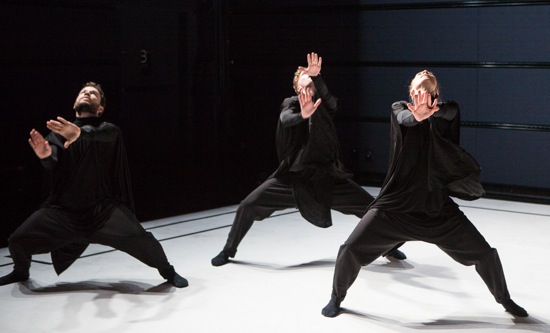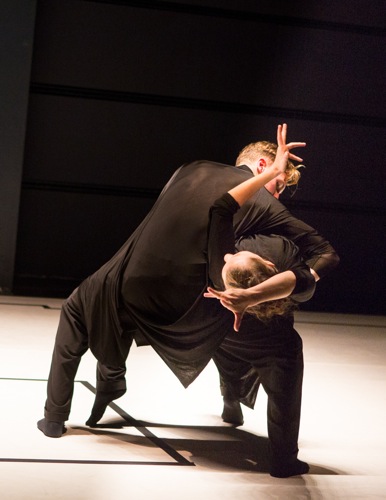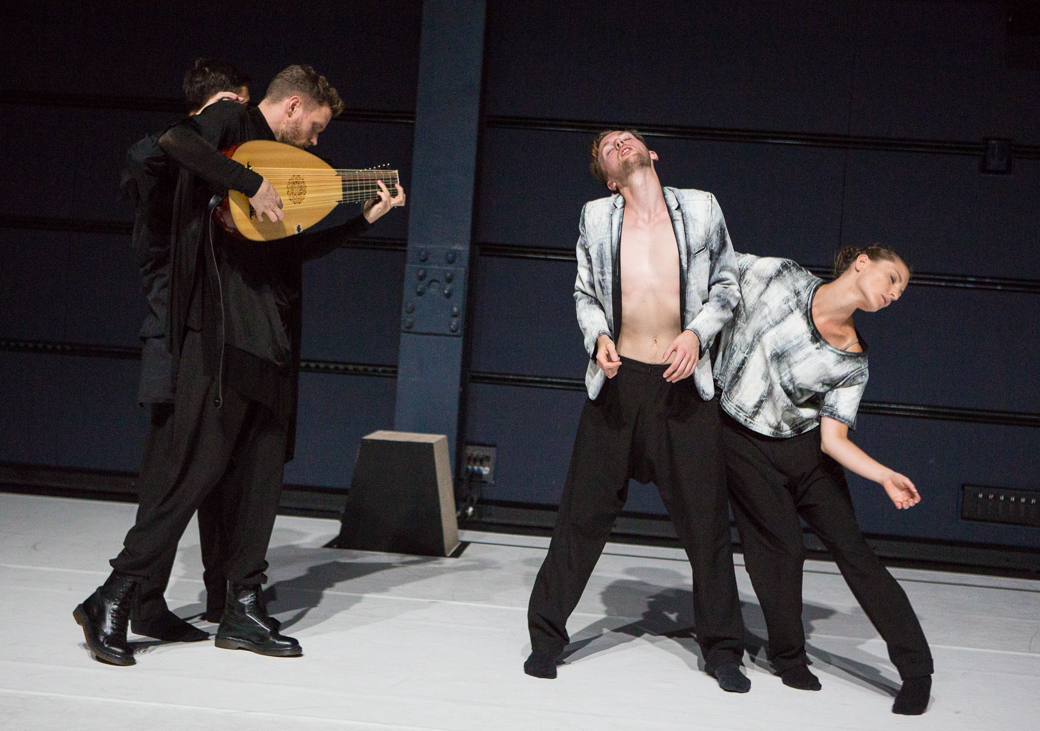K. Kvarnström Co/Kulturhuset City Theatre Stockholm performs at BAM Fisher.

(L to R): Cilla Olsen, Robert Malmborg, Erik Nyberg and lutenist Jonas Nordberg in Kenneth Kvarnström’s TAPE. Photo: Yi-Chun Wu
Eighteen years have passed since I first saw Kenneth Kvarnström’s choreography. That was at a rehearsal in his native Finland. Thirteen years ago, I viewed his beautiful Fragile at Jacob’s Pillow. So I can’t speak knowledgeably about his style, but I do see connections between Fragile and TAPE, which K. Kvarnström & Co. brought to BAM Fisher this past week. (TAPE premiered last year in Sweden, where the choreographer is the artistic director of dance at Kulturhuset City Theatre in Stockholm).
Both pieces present the dancers as members of a community. In TAPE, the six occasionally talk quietly among themselves, as well as intermittently taking turns at a standing microphone to make a point about the choreography, the music, or their private lives. They may slip away from one activity to join another already in progress. Whether dancing or sitting on the sidelines, they’re very aware of one another.
There’s no narrative in TAPE, and its beguiling encounters and tasks appear in musical space as well as stage space. The brilliant lutenist Jonas Nordberg prepares us by playing motifs on his instrument and explaining each and how they relate. The pieces that he plays over the course of the performance is (with the exception Francis Poulenc) by composers of the Baroque Era: Silvius Leopold Weiss, Robert De Visée, and Johann Sebastian Bach. Nordberag also exchanges the lute for a theorbo, its hyper-long stem looming above him, and for a guitar. So the music is lovely, peaceable, and very intricate in terms of the dance that the musician’s fingers execute. He’s not immobile either. Although he has a stylized stump to sit on, he prowls around and into the dancing, on one occasion pushing himself and his instrument intrusively, if benevolently, close to a company member.
These are exceptionally fluent dancers; occasionally they have the look of a person trying to find his/her way into a complicated garment (slip an arm into a sleeve here, pull the bottom edge up with the other hand, and squirm to ease the head through the appropriate opening), yet the overall impression is of bodies twisting and sliding and ducking through unseen pockets of air. In TAPE, Robert Malborg conveys that remarkably in a slippery solo. So does Për Andersson.
Kvarnström avoids aerial choreography in TAPE, although the dancers at times lift one another (Andersson holds Sophie Augot overhead stretched straight as a board for a surprisingly long time). These people are grounded—their knees often bent, their feet wide apart; they’re at home on the floor. Their torsos are extremely flexible; in one thematic move, a dancer bends far to the side, his/her arms reaching out horizontal to the ground. However, they make small, busy gestures with their arms and hands (tricky things with crossing wrists, for imstance) as well as sweeping ones. They crook their arms and set their pointed elbows stirring air; they swoop a curved arm overhead as if calling “come, follow me!” to a distant friend.
At times, I image Kvarnström educating both himself and us in the complexities that lurk within flow and to the ways in which themes interlace and transform. The dancers transform too. Astrid Olsson initially costumes five of them in white trousers and jackets smudged with gray and black and the sixth (Andersson) in a black suit. Over the course of the dance, they all gradually change into black and, at some point flip a black upper garment into something loose and full. Malborg performs his solo in a bulky white top that looks as if a jacket had been deconstructed and re-sewn into something very strange. Andersson at one point wears a black one just like it.
About the title. It refers to the black tape that is laid on the white floor; some is in place when the work begins; dancers unroll tape and create other designs. None of these is curved, and the small overlapping squares and rectangles that result make the performing area of the black-box BAM Fisher resemble the court for a game whose rules we don’t know. A dancer may work within a large framed space, a pair of silver shoes be stashed in a small one.
The dancers also function as music history teachers in decidedly un-pedagogical ways. Erik Nyberg says a few words about the sarabande (considered vulgar by prudes), but Matthew Branham turns a statement about the allemande into an enthusiastically delivered recipe for a gluten-free almond cake.
So there’s a bit of cheekiness and playfulness about TAPE. Soon after it starts, various of the six performers take turns holding up white signs, with hashtags that introduce improvised sections with names like “eyes shut” and “fists.” All of these, the performers depict with practiced skill, as if warming themselves and us up for the intriguing choreographed parts that follow them.
Kvarström lets us see the dancers alone. But the choreography is at its most fascinating in the close-knit trios. Linkages occur and dissipate in order to for new designs to emerge in a fluid, non-stopping architecture of human interdependency. The dynamics of push and pull never contradict the illusion of support and camaraderie. Two trios may work in counterpoint—one threesome, say, making pared-down unison moves side by side, the other three onstage dancers tying themselves into knots— tightening, loosening, looping into another configuration.

(L to R): Matthew Branham, Erik Nyberg, and Sophie Augot in Kenneth Kvarnström’s TAPE. Photo: Yi-Chun Wu
Small, sharp gestures crop up in the flow of movement, but violence never appears. When two of the men circle each other, ducking and feinting, any resemblance to a fight is muted. Nor does outright antagonism mark the duets between a man and one or the other of the two women (Augot and Cilla Olsen). That, however, doesn’t mean that all is harmonious. Nyberg and Augot stand in one spot and make small, tender contacts with each other—caressing a cheek, smoothing hair, wrapping an arm around a pressed-close body. Yet after the two have performed the sequence, they repeat it, and this time they pull away from each other’s hands or duck away from them. They do this without rancor, as if reach-and-parry were an acceptable everyday dance between two people who know each other well.
Kvarnström doesn’t pursue climaxes, nor does he build the level of speed or complexity. Tape maintains the even tone of imaginative encounters and activities among friends. But like an easy-flowing river, whose source and immediate destination you may not know, it contains a wealth of counter-ripples, small obstructions, and quick-vanishing whirlpools.


